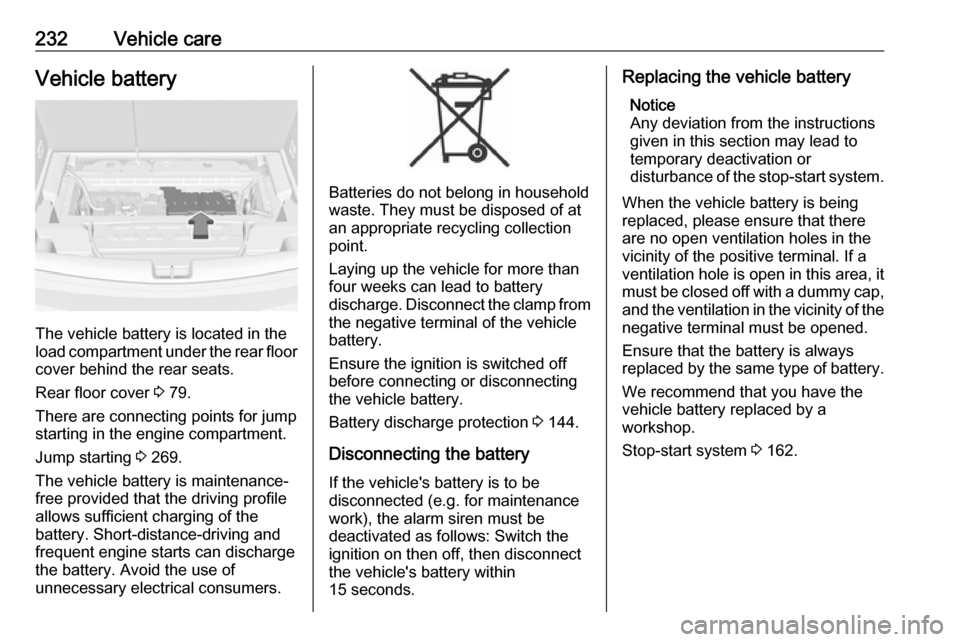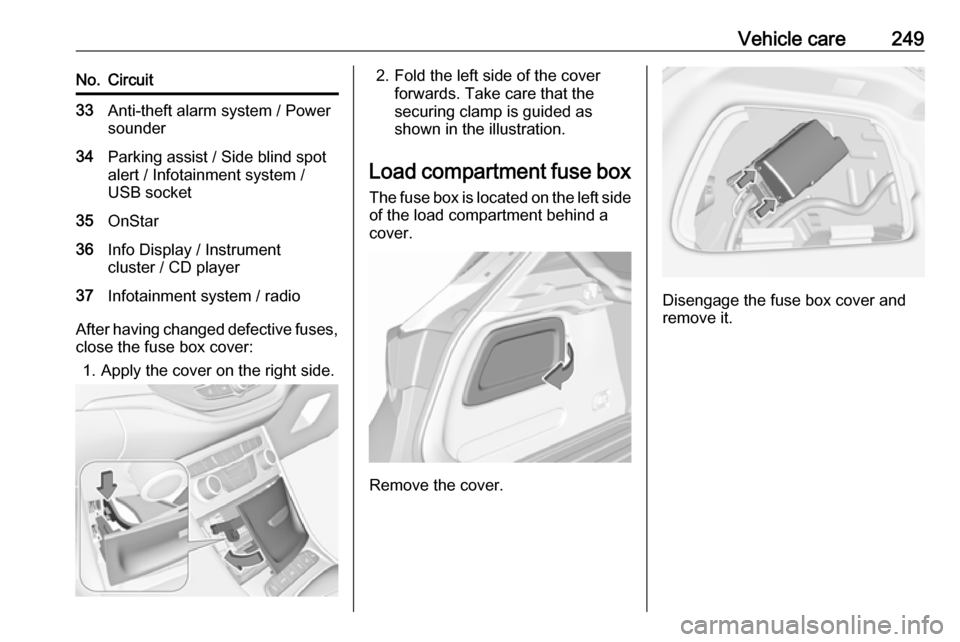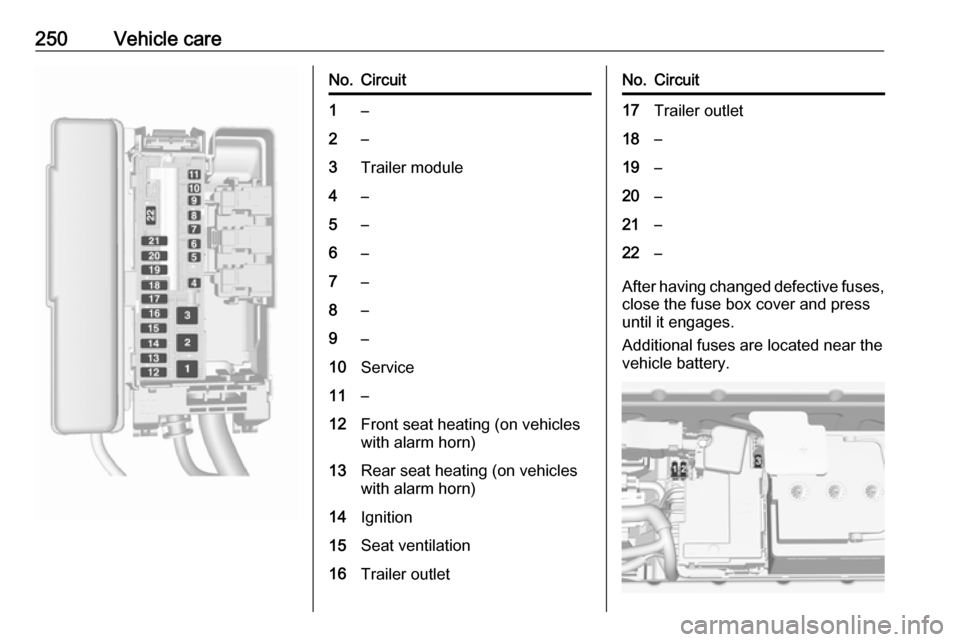alarm VAUXHALL ASTRA K 2019.5 User Guide
[x] Cancel search | Manufacturer: VAUXHALL, Model Year: 2019.5, Model line: ASTRA K, Model: VAUXHALL ASTRA K 2019.5Pages: 311, PDF Size: 9.6 MB
Page 168 of 311

166Driving and operatingFor vehicles with automatic
transmission, the key can only
be removed when the selector
lever is in position P.
● Lock the vehicle by pressing the
button on the door handle or the
button e on the remote control.
● Activate the anti-theft alarm system.
● The engine cooling fans may run
after the engine has been
switched off 3 228.
Caution
After running at high engine
speeds or with high engine loads,
operate the engine briefly at a low load or run in neutral for
approx. 30 seconds before
switching off, in order to protect
the turbocharger.
Notice
In the event of an accident with airbag deployment, the engine is
switched off automatically if the
vehicle comes to a standstill within a
certain time.
Emergency operation under
extreme cold temperatures9 Warning
This emergency operation may
only be carried out in case of
extremely cold temperatures and if the vehicle is parked on a levelsurface.
In countries with extreme cold
temperatures it may be necessary to
park the vehicle without applied
parking brake.
This is an emergency operation to
avoid freezing of the parking brake.
Engine exhaust9 Danger
Engine exhaust gases contain
poisonous carbon monoxide,
which is colourless and odourless and could be fatal if inhaled.
If exhaust gases enter the interior
of the vehicle, open the windows.
Have the cause of the fault
rectified by a workshop.
Avoid driving with an open load
compartment, otherwise exhaust
gases could enter the vehicle.
Exhaust filter
The exhaust filter is a particle filter for diesel and petrol engines.
Page 229 of 311

Vehicle care227Caution
When transporting the vehicle on
a train or on a recovery vehicle, the
mud flaps might be damaged.
Vehicle storage
Storage for a long period of time
If the vehicle is to be stored for several months:
● Wash and wax the vehicle.
● Have the wax in the engine compartment and underbody
checked.
● Clean and preserve the rubber seals.
● Fill up fuel tank completely.
● Change the engine oil.
● Drain the washer fluid reservoir.
● Check the coolant antifreeze and
corrosion protection.
● Adjust tyre pressure to the value specified for full load.
● Park the vehicle in a dry, wellventilated place. Engage first or
reverse gear or set selector lever
to P. Prevent the vehicle from
rolling.
● Do not apply the parking brake.
● Open the bonnet, close all doors and lock the vehicle.
● Disconnect the clamp from the negative terminal of the vehicle
battery. Note that all systems are
not functional, e.g. anti-theft
alarm system.
Putting back into operation
When the vehicle is to be put back into operation:
● Connect the clamp to the negative terminal of the vehicle
battery. Initialize the power
windows 3 40.
● Check tyre pressure.
● Fill up the washer fluid reservoir.
● Check the engine oil level.
● Check the coolant level.
● Fit the number plate if necessary.End-of-life vehicle recovery
Information on end-of-life vehicle
recovery centres and the recycling of
end-of-life vehicles is available on our website, where legally required. Only
entrust this work to an authorised
recycling centre.
Page 234 of 311

232Vehicle careVehicle battery
The vehicle battery is located in the
load compartment under the rear floor cover behind the rear seats.
Rear floor cover 3 79.
There are connecting points for jump starting in the engine compartment.
Jump starting 3 269.
The vehicle battery is maintenance-
free provided that the driving profile
allows sufficient charging of the
battery. Short-distance-driving and
frequent engine starts can discharge
the battery. Avoid the use of
unnecessary electrical consumers.
Batteries do not belong in household
waste. They must be disposed of at
an appropriate recycling collection
point.
Laying up the vehicle for more than
four weeks can lead to battery
discharge. Disconnect the clamp from
the negative terminal of the vehicle
battery.
Ensure the ignition is switched off
before connecting or disconnecting
the vehicle battery.
Battery discharge protection 3 144.
Disconnecting the battery
If the vehicle's battery is to be
disconnected (e.g. for maintenance
work), the alarm siren must be
deactivated as follows: Switch the ignition on then off, then disconnect
the vehicle's battery within
15 seconds.
Replacing the vehicle battery
Notice
Any deviation from the instructions
given in this section may lead to
temporary deactivation or
disturbance of the stop-start system.
When the vehicle battery is being
replaced, please ensure that there
are no open ventilation holes in the
vicinity of the positive terminal. If a
ventilation hole is open in this area, it
must be closed off with a dummy cap,
and the ventilation in the vicinity of the negative terminal must be opened.
Ensure that the battery is always
replaced by the same type of battery.
We recommend that you have the
vehicle battery replaced by a
workshop.
Stop-start system 3 162.
Page 250 of 311

248Vehicle careNo.Circuit1Rear seat heating (only for vehi‐cles without alarm horn)2Climate control system / fan3Power seat driver side4Power seat passenger side5–6Power window front7ABS8Heated steering wheel9Body control module 810Power window rear11Sunroof12Body control module 413Seat heating (only on vehicles
without alarm horn)14Exterior mirror15Body control module 116Body control module 7No.Circuit17Body control module 618Body control module 319Data link connector20Airbag system21Climate control system22Central locking system / tailgate23Electronic key system24Power seat memory function25Airbag system steering wheel26Ignition switch / Steering
column lock27Body control module 228USB socket29Cigarette lighter / Power outlet
front30Selector lever31Rear window wiper32Transmission control module
Page 251 of 311

Vehicle care249No.Circuit33Anti-theft alarm system / Power
sounder34Parking assist / Side blind spot
alert / Infotainment system /
USB socket35OnStar36Info Display / Instrument
cluster / CD player37Infotainment system / radio
After having changed defective fuses,
close the fuse box cover:
1. Apply the cover on the right side.
2. Fold the left side of the cover forwards. Take care that thesecuring clamp is guided as
shown in the illustration.
Load compartment fuse box The fuse box is located on the left side
of the load compartment behind a
cover.
Remove the cover.
Disengage the fuse box cover and
remove it.
Page 252 of 311

250Vehicle careNo.Circuit1–2–3Trailer module4–5–6–7–8–9–10Service11–12Front seat heating (on vehicles
with alarm horn)13Rear seat heating (on vehicles
with alarm horn)14Ignition15Seat ventilation16Trailer outletNo.Circuit17Trailer outlet18–19–20–21–22–
After having changed defective fuses,
close the fuse box cover and press
until it engages.
Additional fuses are located near the
vehicle battery.
Page 306 of 311

304IndexAAccessories and vehicle modifications .......................... 226
Active emergency braking ..........194
Adaptive cruise control .......112, 184
AdBlue ................................ 110, 168
Adjustable air vents ...................154
Airbag and belt tensioners .........107
Airbag deactivation ..............62, 107
Airbag label................................... 57
Airbag system .............................. 57
Air conditioning regular operation ................................ 155
Air conditioning system .............. 147
Air intake .................................... 155
Air vents...................................... 154
Antilock brake system ................ 174
Antilock brake system (ABS) .....109
Anti-theft alarm system ................35
Anti-theft locking system .............. 35
Appearance care ........................272
Armrest ................................... 52, 54
Armrest storage ........................... 71
Ashtrays ....................................... 97 Automatic anti-dazzle ..................40
Automatic light control ...............135
Automatic locking ........................28
Automatic transmission .............171
Autostop ..................................... 162
Auxiliary heater ........................... 154B
Battery discharge protection ......144
Battery voltage ........................... 122 Belts.............................................. 55
BlueInjection ............................... 168
Bonnet ....................................... 228
Brake and clutch fluid .................277
Brake and clutch system ...........108
Brake assist ............................... 177
Brake fluid .................................. 231
Brakes ............................... 174, 231
Breakdown.................................. 270
Bulb replacement ....................... 234
C Capacities .................................. 288
Cargo management system ........81
Catalytic converter .....................167
Central locking system ................23
Centre console lighting ..............143
Changing tyre and wheel size ...259
Charging system ........................ 108 Child locks ................................... 29
Child restraint installation locations ................................... 66
Child restraints.............................. 64
Child restraint systems ................64
Climate control ............................. 15
Climate control systems .............146
Clock............................................. 94